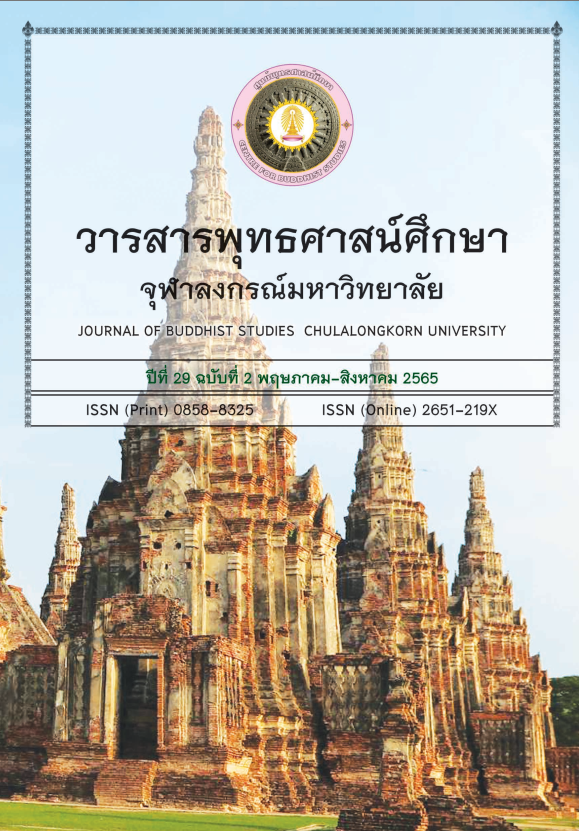Wat Saman Rattanaram’s Formation that Satisfies the Community’s Needs
Keywords:
Formation, Wat Saman Rattanaram, the Community’s NeedsAbstract
In this research paper, an attempt was purposely made to propose the formation of Wat Saman Rattanaram satisfying the community’s needs. This study was methodologically done through the documentary study and interview. The study was considerably shown that the model that satisfies the community’s demand is obviously given by Wat Saman Rattanaram through providing the immediate beneficial temple model to the community wherein people can make a living including the arrangement of environment in such a temple for relaxation where things are orderly and hygienically organized. In addition, the holy statues are also established in order to provide the adherence whereby the faith in certain virtues as appeared in those holy items could be actualized. In the temple, while dealing with the quality and price of products, the management is morally and harmoniously administered by the chief abbot. Furthermore, the establishment of places suitable for worshiping the Buddha’s statues, chanting and making merit is virtually done through planning of construction based on the conservation of architecture and its history as the holy objects concerning with the temple and community are evidently built; the creation of disadvantages is not its focus. It can be said that the model on the construction and mental management is somehow transformed through the cultivation of religious faith, generosity and gratitude. The striking point is greatly emphasized on getting the temple developed as the inseparable part of a community in terms of providing the opportunity for community’s participation in various activities of the temple. Finally, suffice it to say that this temple possesses the physical model of pleasantness and safety wherein the appropriateness is created for all people irrespective of their sex and age.
As far as Wat Saman Rattanaram and the ideal Buddhist temple are concerned, they hold the sameness in terms of being the mental, faithful and generous templehood whereby its management model is considerably made to be the centre of a community that promotes and support the development of community involved and thereby being regarded as the sanctuary in the difficult time, the differences found are that the establishment of various objects in the temple is made according to faith and the development of it is to be the holy items of the country where the practices are in accordance with the community’s ways of life. It can be claimed that, on the one hand, such a model of temple could be found in the formation of a town-temple and city-temple where the chief abbot of such a temple becomes the heart of administration and development, on the other hand, the ideal Buddhist temple lays special emphasis on making a temple suitable for ways of people’s life whose household life is renounced or the ordained; they need tranquility, simplicity and order. The mentioned temple tries to provide suitable place for the recluse more than creation of the new one and thereby being qualified as the model of forest order. Consequently, the construction or restoration of it clearly hinges on the community’s task instead, not Buddhist monks.
Downloads
References
นิโกลาส์ แชรแวส. (2561). ประวัติศาสตร์ธรรมชาติและการเมืองแห่งราชอาณาจักรสยาม. พิมพ์ครั้งที่6. กรุงเทพมหานคร: สำนักพิมพ์ศรีปัญญา.
พระยาสุรินทรฤาชัย. (2561). จดหมายเหตุแห่งพุทธอาณาจักรของพระภิกษุฟาเหียน. กรุงเทพมหานคร: สำนักพิมพ์ศรีปัญญา.
พระไพศาล วิสาโล. (2559). พุทธศาสนาไทยในอนาคต : แนวโน้มและทางออกจากวิกฤต. พิมพ์ครั้งที่ 4. กรุงเทพมหานคร: มูลนิธิโกมลคีมทอง.
พระประชาธรรมนาถ (ไพรัตน์ ปญฺญาธโร). (2559). แนวคิด คติธรรม 19 ปีแห่งวิถีธรรม. ฉะเชิงเทรา: เพอร์เฟค ปริ้นติ้ง แอนด์ ออฟเซท.
พุทธทาสภิกขุ.(2529). ฟ้าสางระหว่าง 50 ปีที่มีสวนโมกข์ (ตอน1). กรุงเทพมหานคร : สวนอุศมมูลนิธิ.
มหาจุฬาลงกรณราชวิทยาลัย. (2539). พระไตรปิฎกภาษาไทย ฉบับมหาจุฬาลงกรณราชวิทยาลัย. กรุงเทพมหานคร : โรงพิมพ์มหาจุฬาลงกรณราชวิทยาลัย.
มหาจุฬาลงกรณราชวิทยาลัย. (2560). อรรถกถาภาษาไทย ฉบับมหาจุฬาลงกรณราชวิทยาลัย. กรุงเทพมหานคร: โรงพิมพ์มหาจุฬาลงกรณราชวิทยาลัย.
มิลินทปัญหา. (2556). มิลินทปัญหา. พิมพ์ครั้งที่ 5. กรุงเทพมหานคร: มหามกุฎราชวิทยาลัย.
วัดสมานรัตนาราม. (2554). วัดสมานรัตนาราม. ฉะเชิงเทรา : หนังสือธรรมทาน.
สมเด็จพระพุทธโฆษาจารย์ (ป.อ.ปยุตฺโต). (2561). ตอบเรื่อง พ.ร.บ.คณะสงฆ์. พิมพ์ครั้งที่ 4. กรุงเทพมหานคร: ผลิธัมม์.
ศรีศักร วัลลิโภดม. (2560). พุทธศาสนาและความเชื่อในสังคมไทย. พิมพ์ครั้งที่ 2. กรุงเทพมหานคร : มูลนิธิเล็ก-ประไพ วิริยะพันธุ์.
อรศรี งามวิทยาพงศ์ และคณะ. (2559). ฟื้นวัด คืนเมือง. กรุงเทพมหานคร: สถาบันอาศรมศิลป์.
อคิน รพีพัฒน์. (2551). วัฒนธรรมคือความหมาย: ทฤษฎีและวิธีการของคลิฟฟอร์ด เกียร์ซ. กรุงเทพมหานคร: ศูนย์มานุษยวิทยาสิรินธร.
ดำรงด์ศักดิ์ มีสุนทร. (2556). ความสัมพันธ์ระหว่างวัดกับชุมชน กรณีศึกษา วัดนามสมมติกับชุมชนนามสมมติ จังหวัดกาญจนบุรี. (วิทยานิพนธ์ปริญญาศิลปศาสตรมหาบัณฑิต, สถาบันบัณฑิตพัฒนบริหารศาสตร์).
Alan Aldridge. (2013). Religion in the Contemporary World: A Sociological Introduction. 3rd Edition. Cambridge: Polity Press.
Max Weber. (1968). Economy and Society: An Outline of Interpretative Sociology. translated and Edited by G. Roth and C. Wittich. New York: Bedminster Press.
Max Weber. (2007). The Religion of India: The Sociology of Hinduism and Buddhism. translated and edited by Hans H. Gerth and Don Martindale. New Delhi: Munshiram Manoharlal Publishers Pvt. Ltd.
Downloads
Published
How to Cite
Issue
Section
License
Copyright (c) 2022 Chulalongkorn University Centre for Buddhist Studies

This work is licensed under a Creative Commons Attribution-NonCommercial-NoDerivatives 4.0 International License.
บทความที่ได้รับการตีพิมพ์เป็นลิขสิทธิ์ของศูนย์พุทธศาสน์ จุฬาลงกรณ์มหาวิทยาลัย
ข้อความที่ปรากฏในบทความแต่ละเรื่องในวารสารวิชาการเล่มนี้เป็นความคิดเห็นส่วนตัวของผู้เขียนแต่ละท่านไม่เกี่ยวข้องกับศูนย์พุทธศาสน์ จุฬาลงกรณ์มหาวิทยาลัย และคณาจารย์ท่านอื่นๆในมหาวิทยาลัยฯ แต่อย่างใด ความรับผิดชอบองค์ประกอบทั้งหมดของบทความแต่ละเรื่องเป็นของผู้เขียนแต่ละท่าน หากมีความผิดพลาดใดๆ ผู้เขียนแต่ละท่านจะรับผิดชอบบทความของตนเองแต่ผู้เดียว






